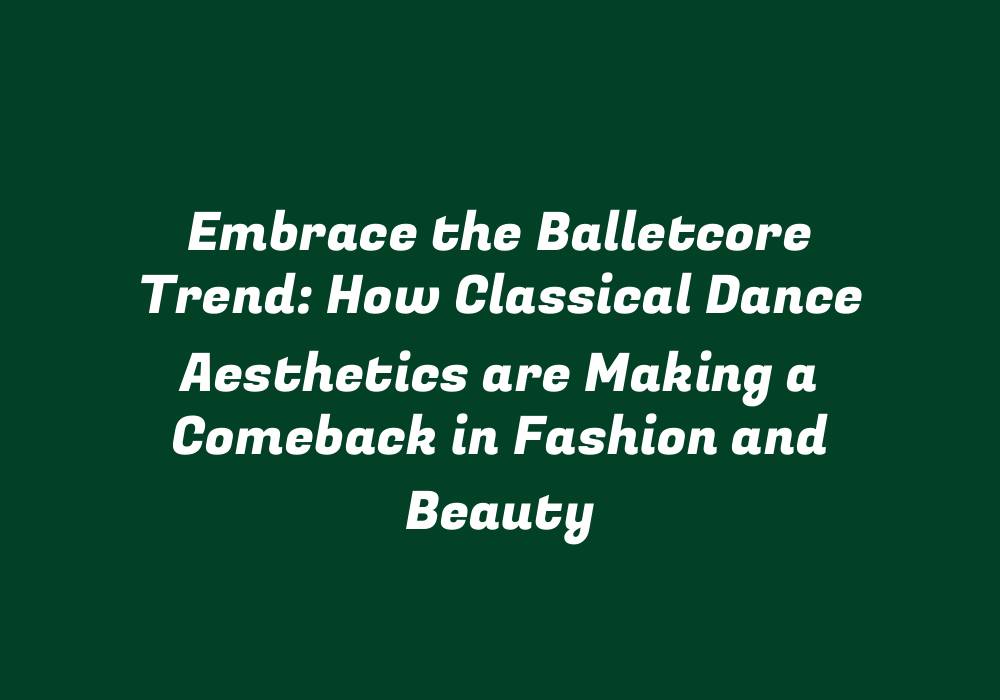Introduction
In recent years, the fashion and beauty industry has experienced a resurgence in the popularity of balletcore. This term describes the growing trend whereby elements from classical dance aesthetics are integrated into everyday fashion and makeup styles. As more and more people embrace this aesthetic, it is essential to understand its origins and how it’s influencing various aspects of modern culture.
Origins of Balletcore
The balletcore phenomenon can be traced back to the 1970s when disco music and aerobics emerged as popular forms of dance and exercise. However, it was in the early 2010s that balletcore started gaining traction, with its origins being found within a group of young dancers who began posting their performances on social media platforms like YouTube and Instagram. This laid the groundwork for ballet-inspired outfits to become a trendy aspect of street style.
Balletcore in Fashion
One of the most visible signs of the growing popularity of balletcore is its integration into contemporary fashion trends. Designers and high-end labels have been inspired by classical dance aesthetics, incorporating pointe shoes, tutus, and tights into their collections. Balmain’s Fall 2017 show featured models wearing bodysuits reminiscent of leotards alongside floor-length coats emulating tutus, while Giambattista Valli included tutu-like skirts in his Spring 2018 collection.
Aside from major fashion houses, streetwear brands have also embraced the trend, with Nike and Adidas releasing ballet-inspired shoe designs that capture elements of dance shoes such as elasticized straps and satin uppers. Additionally, the rise of athleisure wear has further promoted the integration of classical dance aesthetics in everyday outfits, making it easier for people to incorporate balletcore into their personal style.
Balletcore in Makeup
Another way balletcore has made its mark is through the influence it’s had on makeup trends. With an emphasis on clean and fresh looks, makeup artists have reimagined classic dancer-inspired makeup styles to create a look that is both elegant and modern. The focus is on dewy skin, delicate features, and soft hues that mirror the graceful movements of ballet dancers.
A popular technique used in this makeup style is called “ballet face,” which involves creating a porcelain-like finish using lightweight foundation and a highlighter to create a glow similar to that of ballet dancer’s skin. This technique has become increasingly popular among beauty enthusiasts seeking a natural yet polished look.
Balletcore in Dance and Fitness
The revival of balletcore extends beyond just fashion and makeup trends. The return to classical dance techniques has also inspired an increase in interest in traditional ballet classes, as well as the incorporation of ballet-inspired elements into contemporary dance styles. For instance, dance instructors have developed hybrid styles like hip-hop with ballet or even cardio workouts that incorporate basic ballet steps to keep students engaged and challenged.
As a result, there has been an uptick in people looking to add ballet-inspired elements into their fitness routines as well. From barre classes to Pilates reformer workouts, individuals are seeking out balletcore-influenced exercises that promise a combination of grace and strength-building qualities.
Embracing Balletcore: A Unifying Element
The widespread adoption of the balletcore trend signals that people are searching for a sense of unity through shared experiences, particularly during these challenging times when isolation and separation seem to be on the rise. The elegance, grace, and discipline required in classical dance can serve as an inspirational force for individuals seeking to improve their mental and physical well-being.
By embracing the balletcore trend, people are connecting with a centuries-old tradition of artistry, beauty, and athleticism, creating a unique opportunity for personal growth and self-discovery. Through incorporating elements of classical dance aesthetics into their everyday lives, individuals can find solace in this timeless art form while celebrating the many aspects that make us all human: strength, perseverance, and an appreciation for beauty.
Conclusion
The balletcore trend is more than just a passing fad; it represents a deeper connection to our shared cultural heritage and an ongoing effort to reimagine the roles of classical dance in modern society. As we continue to embrace this unique combination of artistry, athleticism, and grace, it’s clear that balletcore will continue to shape the way we think about fashion, beauty, dance, and fitness for years to come.
